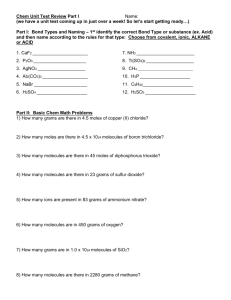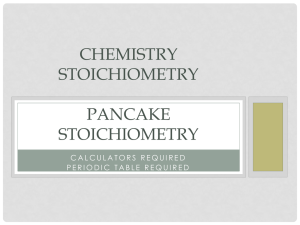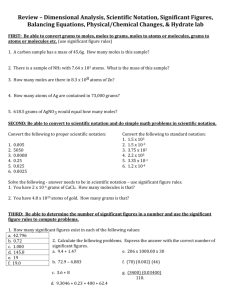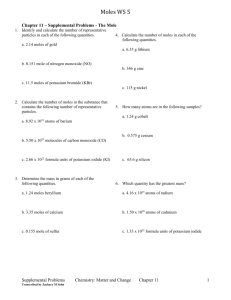Unit 1B Note Packet - Solon City Schools
advertisement
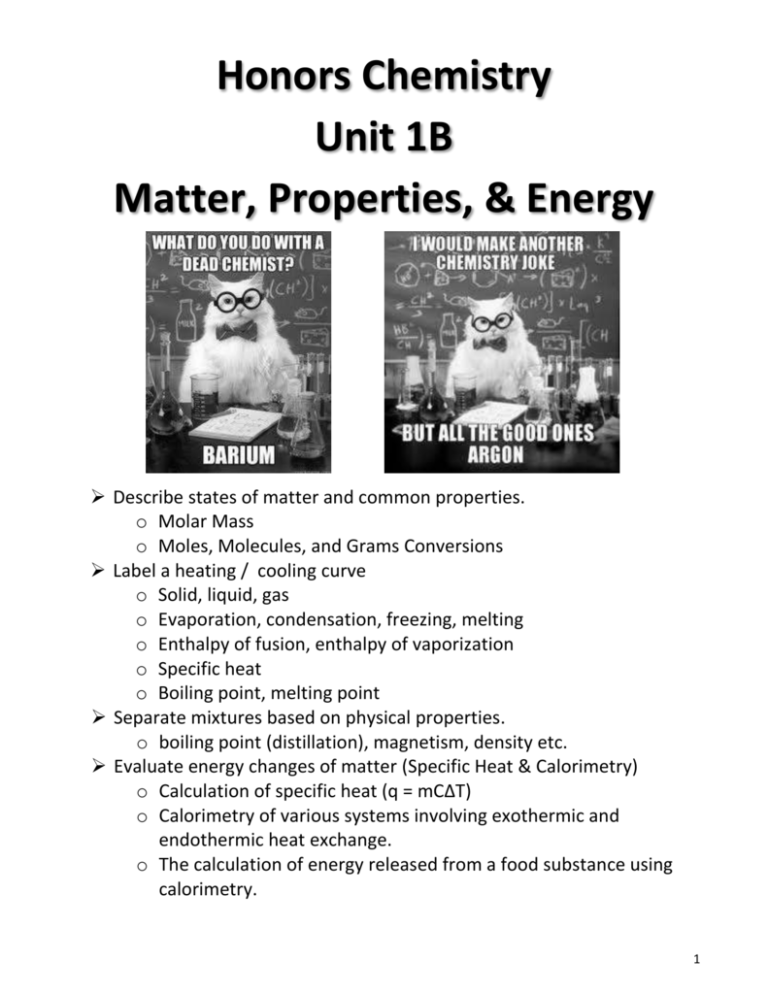
Honors Chemistry Unit 1B Matter, Properties, & Energy Describe states of matter and common properties. o Molar Mass o Moles, Molecules, and Grams Conversions Label a heating / cooling curve o Solid, liquid, gas o Evaporation, condensation, freezing, melting o Enthalpy of fusion, enthalpy of vaporization o Specific heat o Boiling point, melting point Separate mixtures based on physical properties. o boiling point (distillation), magnetism, density etc. Evaluate energy changes of matter (Specific Heat & Calorimetry) o Calculation of specific heat (q = mCΔT) o Calorimetry of various systems involving exothermic and endothermic heat exchange. o The calculation of energy released from a food substance using calorimetry. 1 We are looking for: 1a. Calculate the molar mass of a compound/element using a periodic table. 1b. Using molar mass and unit analysis, convert moles of a given compound to grams of that compound and vice versa. 1c. Using Avogadro’s number and unit analysis, convert atoms/molecules of a compound to moles of that compound. 2a. Physical properties such as boiling point, magnetism, density etc. 2b. Measure the density of various samples and use the density to identify the material. 3a. Identification of all phase changes and energy change values 3b. Evaporation, condensation, freezing, melting 3c. Enthalpy of fusion, enthalpy of vaporization 3d. Specific heat 3e. Boiling point, melting point 3f. Solid, liquid, gas 4a. Calculations of energy released/gained using specific heat (q = mCΔT) 4b. Calorimetry of various systems involving exothermic and endothermic heat exchange. 4c. The calculation of energy released from a food substance using calorimetry. What’s the MATTER Matter: Anything that has _______ and takes up __________. Matter is made up of building blocks: _________ – smallest unit of an element. _________ – a pure substance made of only one kind of atom. _________ – made of two or more atoms that are chemically combined. 90% of the Earth’s crust is made up of only 5 elements: Oxygen 49.2% Silicon 25.7 % Aluminum 7.5% Iron 4.7% Calcium 3.4% States of Matter Solid Definite __________ and ___________ Particles are __________ packed Slight expansion when ___________ Incompressible 2 Liquid Has definite __________, but no definite __________ (assumes the shape of the container) Particles are ____________ packed (can flow) Easily expand when ___________ Considered incompressible Gas No definite ___________or ___________ ___________ to fill the container Particles are spaced _______ apart Compressible Plasma Consists of _______________ charged particles It’s an ionized _________ Common in __________, but very rare on ____________ Found in lightning, fluorescent lights and neon signs Energy Amounts in States of Matter Solid- little energy, particles vibrate and rotate Liquid- more energy, they move freely Gas- even more energy, move quickly Plasma- most energy, move extremely fast Names of Phase Changes Solid to Liquid Liquid to Gas Gas to Liquid Liquid to Solid Solid to Gas Gas to Solid = ______________ = Boiling / Evaporation = ______________ = Freezing = ______________ = Deposition Types of Matter Pure Substance Matter with a ________ composition It has distinct properties Examples = elements compounds Mixtures Most matter is a mixture The composition is not fixed (changes from sample to sample) Two Types – ____________________ ____________________ 3 Homogeneous Mixtures: Composition is ______________ throughout Solution Particle size = 0.01 – 1 nm Doesn’t settle out upon ________________ Can’t be separated by __________________ Doesn’t scatter _____________ Example = distilled water Heterogeneous Mixtures Composition is ______________ throughout Suspension The sample varies in composition, properties and _______________ No ______________ Particle size is greater than 1000 nm Particles ____________________ upon standing Can be separated by filtration Might scatter light Examples = soil, trail mix, _________________ Colloid Particle size = 1 – 1000 nm Doesn’t settle out upon standing Can’t be separated by filtering Scatters light ( ____________________ ) Examples = milk, gelatin, smoke Physical vs. Chemical Properties Every substance has a unique set of properties (characteristics that identify that substance) Physical Change A change in matter from one form to another without changing its ______________________________ (most can be reversed) Examples = Change in state Dissolving Compressing Physical Properties Properties that can be measured without changing the identity and composition of the substance Physical Property Examples Color Odor Density Melting Point Boiling Point Hardness Solubility 4 Chemical Change A change in matter from one form to another by changing its ______________________________ (most cannot be reversed) Examples of what to look for = Chemists Get Practice Trying Labs C__________ G__________ P__________ T__________ L__________ Examples = Combustion Electrolysis of water Any reaction that produces a new product like water, a gas, a solid (precipitate in solution) Chemical Properties Properties that describe the way a substance may change to form other substances Only observed when a _______________________takes place Chemical Property Examples Heating to combustion Reactivity with water or acid Flammability Corrosion Decomposition Law of Conservation of Mass = In a physical change or a chemical reaction, mass is neither created nor destroyed (Antoine Lavoisier) 5 Density Density is a measure of mass per volume. D= Answer the following questions on density and experimental error. Show all your work with units and round your answer to the correct number of sig. figs.! 1. What is the density of a cardboard if 6.2 g occupy 8.56 cubic centimeters? 2. What is the density of a gold nugget having a volume of 2.39 cubic centimeters and a mass of 45.58 grams? 3. What is the mass of a piece of aluminum having a volume of 15.12 cubic centimeters and a density of 2.70 grams per cubic centimeter. 4. Cerium sulfate has a density of 3.17 grams per cubic centimeter. What is the volume of .54 grams of this substance? 5 What is the density of a brick if 51.21 g occupy 31.32 cubic centimeters? 6. Cerium sulfate has a density of 3.17 grams per cubic centimeter. What is the volume of 1.25 grams of this substance? 7. Tin has a density of 7.28 grams per cubic centimeter. What is the volume of 11.2 grams of this substance? 6 Percent Error (Experimental Error) Density and Percent Error Practice 1) You measure the density of substance in the lab as 4.25 g/mL. The true value of the density of the substance is 4.32 g/mL. Calculate your percent error. 2) Your measurement of the volume of a sample of tap water is 9.6 mL, 9.52 mL and 9.553 mL using 3 different graduates. What is the average volume of the tap water? 3) The average mass of this tap water is 9.2 g, what is the density? 4) The standard density of water is 1.00 g/mL, What is your percentage error for the above problem? 7 Layered Solutions Activity Objective: To create a column of distinct layers of different solutions. Procedure: 1. In five different cups, place the following ingredients: a Chart 1: Ingredients for layered solution (you must use at least 20mL but each cup must use different volume of water and each must differ by at least 10 mL). Cup Number Salt (g) Warm water (mL) Calculated Density (g/mL) 2. Once you have added all of the necessary materials, stir each one with a spoon for at least one minute until all of the salt is completely dissolved. 3. Using sig figs, calculate the density for each cup and record the density in the last column of Chart 1. 4. Using the balance and 10 mL of each solution you just made, measure the density of each solution. Record these values for density in Table 1 on the back of this sheet. 5. Determine the order to put the liquids into the graduated cylinder. Which one should go in first, the least dense or the most dense? 6. Add food coloring to create a rainbow effect with the different layers. 7. Using your pipette, carefully transfer 20 mL from each cup into the 100 mL graduated cylinder. Observations: Table 1: Data from the Layered Solution Activity Cup Number Measured Density from solutions made (g/mL) Projected order to fill graduated cylinder The best layers will win a prize!!! 8 Lab: Graphing and Density Name:________________________ Class Period:_____ Purpose: -Determine the density of a liquid from a graph of mass and volume. -Determine the layering order of three liquids if poured together into a graduated cylinder. Problem: Are density and the layering order of liquids in a graduated cylinder related? Hypothesis: (If…,then…) Experiment: Materials: 25mL graduated cylinder balance rubbing alcohol water dropper calculator Procedure: 1) Determine the mass of 5mL of water and record this in the data table. a. Place the empty graduated cylinder on the balance and record this mass below: i. Mass of empty cylinder:_____________g b. Place the 5mL of water in the cylinder and carefully place it on the balance. c. Subtract the mass of the empty cylinder. d. Record the mass in the data table. 2) Repeat step 1 for 15mL and 25mL of water. 3) Repeat step 1 for 5mL, 15mL, and 25mL of rubbing alcohol. a. Use the beaker of rubbing alcohol that is at your table. Return the alcohol to the beaker when finished for the next class to use!! 4) We will not be measuring the values for silicone oil because it is too messy. The data has already been given to you in the data table. 5) Graph the data on the provided graph under the data table. a. Use a different colored pencil for each line. b. Provide a key to identify each color. c. Make a title for the graph. d. Make a best-fit line for each color. The line must go through 0,0. e. Determine the slope of each line and show your work. 9 Data: Volume (mL) Water Mass (g) Rubbing Alcohol 5.00 Silicone Oil 4.60 15.0 13.70 25.0 23.10 Slope determination of each line to calculate the density of each liquid: (You MUST show your work! Remember to put units with your work and answer.) Circle your answer. Water: Rubbing alcohol: Silicone oil: Given your results, how will the liquids be layered if poured carefully into a graduated cylinder? Make sketch show which liquid would form the bottom… will be in the middle, and … will be on top. 10 Stoichiometry From 2 greek words: Stoicheion = element 1792 – German Chemist Metron = measure Jeremias Benjamin Richter Is concerned with the amount of substances involved in a reaction Composition stoichiometry = mass relationships between elements in compounds Ex: Na2SO4 2 Na / 1 SO4 Avogadro’s Number = Number of particles in a mole 6.02 X 1023 602,000,000,000,000,000,000,000 (Named after Amadeo Avogadro – 1776-1856 Italian chemist and physicist) Molar Mass Mass in grams of one mole of an element or compound Numerically equal to the atomic weight of the element or the sum of all the atomic weights in the formula 11 Molar Mass Examples 1. NaCl = 22.99 + 35.45 = 58.44 g/mole 2. CuSO4 5H2O = 63.55 + 32.07 + 4(16.00) + 5(18.00) = 159.62 + 90 = 249.62 g/mole Calculate the Molar Mass for each of these compounds. 1. KCl 2. Li2SO4 3. (NH4)2C2O4 H2O 4. Potassium Hydroxide 5. Copper (II) Bromide 6. Magnesium Phosphate 7. Trisilicon Heptoxide 12 Converting Moles to Grams and Converting Grams to Moles Convert the given moles into grams or given grams to moles. Write the answer to the problem on the line provided. Show all of your work in the space on the right. Report all answers to 2 decimal places. Work Space __________ 1. 7.8 moles of Fe2O3 __________ 2. 100.2 moles of Pb(NO3)2 ___________3. 1.22 moles of CO2 to grams __________ 4. 120.8 grams of K2SO4 to moles __________ 5. 4.6 grams of MgCl2 to moles __________ 6. 2.3 grams of Ba3(PO4)2 to moles 13 Converting Moles to Molecules (particles) And Back Again 1. 4.50 Moles = ? Molecules 2. 6.62 x 1024 Molecules = ? Moles 3. 91.20 Moles = ? Molecules 4. 3.01 x 1023 Molecules = ? Moles 5. 1345.9 Moles = ? Molecules 14 More Converting… 1. 2. 3. 4. Iron 18.06x 1023 molecules = ? grams CuSO4 1.20 x 1028 molecules = ? grams MgCl2 380.84 grams = ? molecules Pb(NO3)2 82.81 grams = ? molecules Moles And Compounds Worksheet Directions: Write the answer to the problem on the blank provided. The correct set-up must be to the right of the problem. ______________1. .738 moles of Fe2O3 to grams ______________2. 50.5 g of FeBr3 to moles ______________3. 1.51 x 10 23 molecules of PbI2 to moles ______________4. .445 moles of CCl4 to molecules ______________5. .538 moles of Ce2(CO3)3 to grams ______________6. 150.4 g of Ce(CO3)2 to moles ______________7. 7.22 x 10 25 molecules of CuCl2 · 4 H2O to moles ______________8. 1.45 moles of Pb(C2H3O2)2 to grams ______________9. 1.22 x 10 24 molecules of CO2 to grams _____________10. 19.3 grams of H2O to molecules 15 Heating and Cooling Curve Definitions Specific Heat – Solid – LiquidGas – Plasma – Heating Curve Enthalpy of Fusion/ Molar heat of fusion– Melting– Melting Point – Enthalpy of Vaporization/Molar heat of Vaporization– Evaporation– Boiling Point – Sublimation- Cooling Curve – Condensation – Condensation Point – Freezing – Freezing Point – Deposition - 16 The graph below shows the relationship between heat (energy) added, in calories (cal), and temperature for 1 g of water. A student applied heat to 1 g of ice that had been cooled to -40⁰C and measured the rise in temperature. Read and fill-in the notes below and on the following pages and label the steps/regions A, B, C, D, E on the graph. Step A:Solid Water (Ice) Rises in Temperature (Keep in mind the graph is for water!) If the __________________ is not at 0oC, it will rise as heat is ____________to get there. (Kinetic energy is _________________) Each gram of water requires a constant amount of energy to increase 1o = specific heat IMPORTANT – the ice has not________________ yet! Step B: Solid Water (Ice) Melts By ______________energy the ice begins to _____________. 17 Temperature does not ___________ as more energy is being ______________ (Kinetic energy is _____________________ but potential energy is ____________) Each mole of water requires a given amount of energy to melt = molar heat of fusion (∆ Hfus) in kJ / mole. Energy is overcoming water molecules attraction for each other so it can be converted from a solid to liquid. How many calories of energy did it take to completely change the 1 gram of solid water (ice) at 0⁰C to liquid water?________________________ Step C: Liquid Water Rises in Temperature Now the ice is completely _________ and the water temperature begins to _________________ as heat is ________________. (specific heat) Kinetic energy is ______________________. The water has not started to____________ yet. How many calories of energy did it take to make the 1 gram of liquid water to change temperature from 0⁰C to 100⁰C (just beginning to boil)?____________ Step D: Liquid Water Boils As we __________ energy the temperature does not change. Each mole of water will require a constant amount of energy to boil = molar heat of vaporization (∆Hvap) KJ/mole. The energy is being used to overcome water's attraction to each other to convert the liquid to a gas (kinetic energy _________________ but potential energy is _________________). How many calories of energy did it take to make the 1 gram of liquid water to completely turn to steam once it hit 100⁰C?________________________ 18 Step E: Steam Rises in Temperature Temperature ___________ again when all water is turned to steam Each gram of water requires a constant amount of energy to rise 1o = specific heat. Specific Heat Capacity “C” The amount of energy required to be absorbed to warm 1 gram of a substance by 1 oC (or 1 K) or the amount of energy required to be released to cool 1 gram of a substance by 1 o C (or 1 K). -orHow easily things warm up & cool down. Energy Calculations Involving Specific Heat: q = mC∆T where: q = Heat Energy + q means heat/energy is being absorbed (endothermic process) - q means heat/energy is being released (exothermic process). m = mass in grams c = specific heat capacity (also “s”) ∆T = change in temperature (temperature final – temperature initial) Energy Units: Heat energy (q) is in joules(J), kilojoules (kJ) or calories (cal). 1 calorie = 4.184 joules Mass (m) is in grams or kilograms Specific heat capacity, c, is in J/g oC or kJ/kgoC Water (L) = 4.184 J/goC Water (s) = 2.03 J/goC Water (g) = 2.0 J/goC Temperature , T, is usually in oC (temperature can be in K) 19 Metals have low specific heat values Aluminum 0.900 J/goC Iron 0.450 J/goC Gold 0.126 J/goC Doesn’t take much heat to heat them up and they don’t hold the heat well!!! (better conductors of heat/energy) Water and organic materials hold heat much better – have higher specific heats also takes more energy to heat them up. (better insulators of heat/energy) Water = 4.184 J/goC Wood = 1.76 J/goC cal/g K or Molar C Btu/lb F J/mol K Substance J/goC Aluminum 0.900 0.215 24.3 Bismuth 0.123 0.0294 25.7 Copper 0.386 0.0923 24.5 Brass 0.380 0.092 ... Gold 0.126 0.0301 25.6 Lead 0.128 0.0305 26.4 Silver 0.233 0.0558 24.9 Tungsten 0.134 0.0321 24.8 Zinc 0.387 0.0925 25.2 Mercury 0.140 0.033 28.3 2.4 0.58 111 Water 4.184 1.00 75.2 Ice (-10 C) 2.05 0.49 36.9 Granite .790 0.19 ... Glass .84 0.20 ... Alcohol(ethyl) 20 Name _____________________________________ Energy & Specific Heat Problems 1. How much heat energy does a copper sample absorb if its specific heat is 0.386 J/g oC, its mass is 12.5 g and it is heated from 25.0 oC to 40.0 oC? 2. How much heat energy is released by 10.0 g of gold, when it is cooled from 35.0 oC to 25.0 o C? The specific heat of gold is 0.129 J/g oC. 3. A 4.00 kg sample of iron was heated from 0.0 oC to 20.0 oC. It absorbed 35.2 kJ of energy as heat. What is the specific heat of this piece of iron? 4. 42.6 J of energy is needed to heat 2.00 grams of carbon from 50.0 oC to what final temperature? The specific heat of carbon is 0.790 J/g oC. 21 Name _____________________________________________ Energy & Specific Heat Problems2 1. What amount of heat is required to raise the temperature of 85.9 g of water by 7.0C? 2. When 1045 joules are absorbed by a certain mass of water, the temperature of the water increases from 45.0 ºC to 50.0 ºC. What is the mass of the water sample? 3. How many joules are required to heat 38.0 grams of gold from 60.0 ºC to 260.0 ºC? The specific heat of gold is 0.126 J/(g·ºC). 4. Iron has a specific heat of 0.450 J/(g·ºC). If 1400. joules are absorbed by a chunk of iron that weighs 40.0 grams, how much does the temperature of the iron increase? 22 Name _____________________________________ More Energy & Specific Heat Problems **Pay attention to units AND sig figs** 1. What is the specific heat value of a sample of unknown material, if it weighs 36.359 grams and 59.912 J of heat raise its temperature 152.0 oC? 2. What would be the final temperature of a 73.174 g sample of cobalt with an initial temperature of 102.0 oC, after it loses 800 J? (The specific heat of cobalt is 0.4210 J/goC) 3. What mass of iron would release 0.1854 kJ when its temperature changed from 1550.0 oC to 75.0 oC? (The specific heat of iron is 0.450 J/g oC) 4. The specific heat of mercury is 0.0335 cal/g oC. If 152.00 g of mercury at 75.0 oC are cooled to 23.5 oC, what is the value of q in Joules? 5. Kelly has 2.00 kg of water at 80.0 oC and wants it to cool to 45 oC. If the water releases 20.9 kJ of energy every minute, how long will it take to cool? 23 Calorimetry From the point of view of the system Endothermic Exothermic Feels cold Feels hot Surroundings lose heat (energy) Surroundings gain heat (energy) System gains energy System loses energy (+) Energy term Energy is absorbed (-) Energy term Energy is released Measured in Joules Measured in Joules To convert between Joules and Calories: 1 calorie = 4.184 Joules 24 Calorimeter Q water = -Q system Mass H2O x CH2O x ∆TH2O = Mass sys x Csys x ∆Tsys Mass H2O x CH2O x ∆TH2O = Mass sys x Csys x ∆Tsys 25 Name:________________________________ Calorimetry Problems 1) A 2.8 kg sample of metal with a specific heat of 0.43 kJ/kg°C is heated to 100.0°C and then placed in a 50.0g sample of water at 30.0°C. What is the final temperature of the water and the metal? 2) The specific heat of mercury is 0.033 cal/g°C. If 152g of mercury at 75.0°C is placed in 145g of water at 23.5°C, what will be the final temperature of the water? 3) A 37.7 g piece of metal is heated to 100.0C and placed into 75.0 g of water in a coffee- cup calorimeter. Initially, the temperature of the water in the calorimeter was 23.1C. After the metal was added to the water the temperature of the water increased until its temperature and the temperature of the metal were 30.6C. a. What is the specific heat of the metal? b. What kind of metal was added to the water in the calorimeter? 26 4) A 440.00 g sample of mercury (specific heat = 0.140 J/goC, initial temperature of 22.00oC) is placed into 134.00 g of water (initial temperature of 35.00oC). Find the final temperature of the system. 5) Abbey is testing her baby’s bath water and finds that it is too cool, so she adds some hot water from kettle on the stove. If Abbey adds 2.00 kg of water at 80.0°C to 20.0 kg of water at 27.0°C, what is the final temperature of the bath water? 6) Jason is emptying the dishwasher. He removes a 0.200 kg glass that has a temperature of 30.0°C. Into the glass, he pours 0.100 kg of diet soda (mostly water) which comes out of the refrigerator with a temperature of 5.00°C. Assuming no external heat loss, what will be the final equilibrium temperature of the glass of diet soda (no ice was added)? (c for glass =0.84 J/g°C). 27 Name ___________________________________________________________________ More Calorimetry Problems 1) 45.3 g of a shiny metal, with a specific heat of 0.561 cal/g ⁰C, is placed into a water bath that has a temperature of 99.7 ⁰C. It is then placed into a calorimeter that has 54.7 mL of water. If the water and the metal end up with a temperature of 17.2 ⁰C, what was the initial temperature of the water in the calorimeter? 2) A metal with a mass of 97.4 g is heated to a temperature of 81.4 ⁰C. It is then placed into a calorimeter containing 0.246 kg of benzene, which has a specific heat of 1.74 J/g ⁰C. The temperature of the benzene rises from 15.5 ⁰C to 32.5 ⁰C. What is the specific heat of the metal in calories? 3) A metal with a specific heat of 0.126 cal/g ⁰C is placed into a water bath with a temperature of 94.5 ⁰C. The metal is then placed into a calorimeter containing 86.5 g of acetic acid at a temperature of 20.6 ⁰C. The acetic acid and metal have a final temperature of 35.5 ⁰C. The acetic acid has a specific heat of 2.05 J/g ⁰C. What is the mass of the metal? 4) A metal with a specific heat of 2.03 J/g ⁰C and a mass of 68.5 g is placed into a hot water bath with a temperature of 74.5 ⁰C. The metal is then placed into a calorimeter containing acetic acid at a temperature of 14.5 ⁰C. The final temperature of the acetic acid and metal is 45.5 ⁰C. The density of acetic acid is 1.04 g/mL and a specific heat of 0.49 cal/g ⁰C. What is the volume of acetic acid in the calorimeter? 28 Distillation Apparatus: Separating a mixture of liquids based upon the boiling point of each liquid. 29 Using the graphed data and the table of compounds and their boiling point temperatures, which compound(s) is definitely not in the mixture?_______________________________ Which compound(s) are definitely in the mixture?_____________________________ 30

